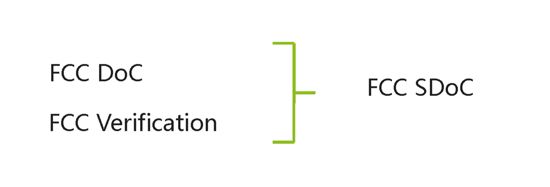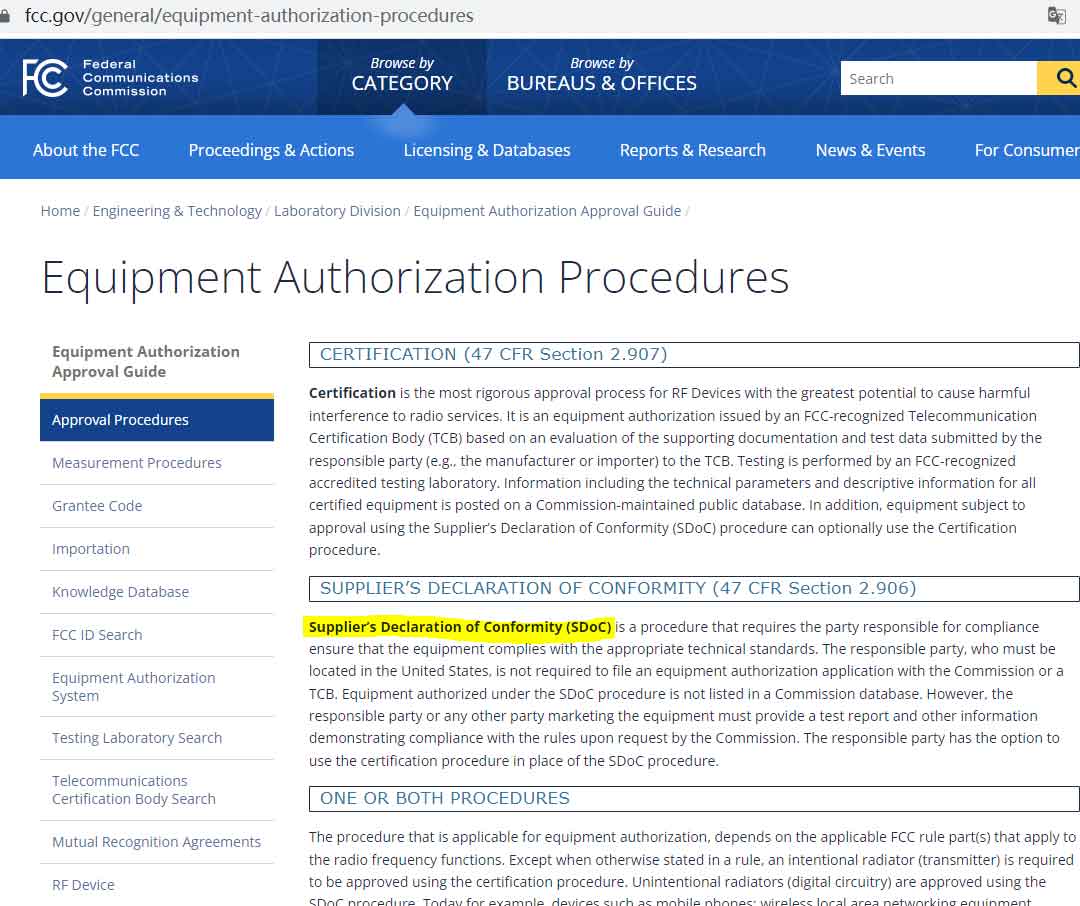The United States FCC SDOC refers to Supplier’s Declaration of Conformity, or Supplier’s Declaration of Conformity, or SDoC for short. The equipment supplier (note: the supplier must be a local company in the United States) will test the equipment that meets the specified standards or requirements, and the equipment that meets the regulations must provide relevant documents (such as SDoC declaration documents) to provide proof to the public. The SDoC policy simplifies the previously complicated FCC certification requirements and further reduces the burden on enterprises.

SDOC certification means that all electronic and electrical products going to the United States need to comply with FCC PART 15B of the United States, that is, all previous electronic and electrical products that comply with FCC VoC and FCC DoC.
FCC SDoC changes
- There are clear requirements for the person in charge of the product, and the contact information of the U.S. company needs to be provided. The responsible party can be the importer or consignee or customs broker. At the same time, after November 2, 2018, the FCC DOC and FCC VOC will be invalid;
- All SDoC products can independently choose whether to mark the FCC Logo;
- The authentication methods of our common equipment have undergone major changes. Except for wireless transmission products/scanning receivers/power line broadband access/radar detection products, FCC ID must be made, and all other products can choose FCC ID or SDOC.
SDoC product range
In applying for FCC certification, FCC SDoC applies to ordinary products without wireless functions, such as displays, ordinary household appliances, lamps, etc. Including personal computers and peripheral equipment; household appliances; electric tools; audio and video products; lamps; toys; security products, etc. Such as monitors, mice, refrigerators, electric kettles, hair dryers, LED lamps, electronic toys, ordinary access control and other products.
FCC Class A or B
§ 15.3 Definitions.
(h) Class A digital device. A digital device that is marketed for use in a commercial,industrial or business environment,exclusive of a device which is marketed for use by the general publicor is intended to be used in the home.
(i) Class B digital device. A digital device that is marketed for use in a residential environment notwithstanding use in commercial, business and industrial environments. Examples of such devices include, but are not limited to, personal computers, calculators, and similar electronic devices that are marketed for use by the general public.
NOTE: The responsible party may also qualify a device intended to be marketed in a commercial, business or industrial environment as a Class B device, and in fact is encouraged to do so, provided the device complies with the technical specifications for a Class B digital device. In the event that a particular type of device has been found to repeatedly cause harmful interference to radio communications, the Commission may classify such a digital device as a Class B digital device, regardless of its intended use.
FCC SDOC conducted emission limit
§15.107 Conducted limits.
(a) Except for Class A digital devices, for equipment that is designed to be connected to the public utility (AC) power line, the radio frequency voltage that is conducted back onto the AC power line on any frequency or frequencies within the band 150 kHz to 30 MHz shall not exceed the limits in the following table, as measured using a 50 μH/50 ohms line impedance stabilization network (LISN). Compliance with the provisions of this paragraph shall be based on the measurement of the radio frequency voltage between each power line and ground at the power terminal. The lower limit applies at the band edges.
| Frequency of emission (MHz) | Conducted limit (dBμV) | Conducted limit (dBμV) |
|---|---|---|
| Quasi-peak | Average | |
| 0.15-0.5 | 66 to 56* | 56 to 46* |
| 0.5-5 | 56 | 46 |
| 5-30 | 60 | 50 |
(b) For a Class A digital device that is designed to be connected to the public utility (AC) power line, the radio frequency voltage that is conducted back onto the AC power line on any frequency or frequencies within the band 150 kHz to 30 MHz shall not exceed the limits in the following table, as measured using a 50 μH/50 ohms LISN. Compliance with the provisions of this paragraph shall be based on the measurement of the radio frequency voltage between each power line and ground at the power terminal. The lower limit applies at the boundary between the frequency ranges.
| Frequency of emission (MHz) | Conducted limit (dBμV) | Conducted limit (dBμV) |
|---|---|---|
| Quasi-peak | Average | |
| 0.15-0.5 | 79 | 66 |
| 0.5-30 | 73 | 60 |
FCC SDOC Radiation Test Limit Request
§15.109 Radiated emission limits.
(a) Except for Class A digital devices, the field strength of radiated emissions from unintentional radiators at a distance of 3 meters shall not exceed the following values:
| Frequency of emission (MHz) | Field strength (microvolts/meter) |
|---|---|
| 30-88 | 100 |
| 88-216 | 150 |
| 216-960 | 200 |
| Above 960 | 500 |
(b) The field strength of radiated emissions from a Class A digital device, as determined at a distance of 10 meters, shall not exceed the following:
| Frequency of emission (MHz) | Field strength (microvolts/meter) |
|---|---|
| 30-88 | 90 |
| 88-216 | 150 |
| 216-960 | 210 |
| Above 960 | 300 |
Typical question and answer
- Should the lighting products be grade A or grade B? Answer: According to the standard lamps, if they are installed in the home, they must meet the B-level limit requirements. If they are installed in outdoor or industrial environments, they can use the A-level limit requirements.
- Is FCC Part 15 Grade B easy to pass, or is FCC Part 15 Grade A easy to pass? Answer: According to the limits stipulated in the standard, the limit of Class A is significantly higher than the limit of Class B, which means that Class A is easier to pass in the case of the same sample.
- Can FCC test data of A and B levels be interchangeable? If the data is tested to level B, if level B does not meet the requirements, can it be replaced with level A? Answer: Of course, it can be interchanged. The data will not change. Only the limit value is changed. Generally, the test software can easily exchange the A-level and B-level limits. Please confirm and communicate with the test engineer. For example, if you are taller than Yao Ming and taller than Zhangwei, your height remains the same, and what you change is just a reference.
You are welcome to consult us, please contact David Zeng info@emc.wiki or 1513888718@qq.com , We can provide one-stop testing, EMC debug and certification services.


